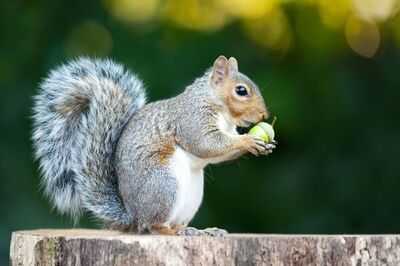
With countryside paths littered with autumn acorns, conservation charities have explained the bumper crop is all down to Britain having a "mast year". The National Trust said a "mast year" occurs around once every four years and involves certain tree species producing unusually high numbers of nuts and berries.
Dr Andrew Hacket Pain, from the University of Liverpool, said it follows a combination of factors, such as this year's warm and dry spring, which promoted the pollination of oak flowers. Owen Phillips from the Woodland Trust said the number of nuts produced by some of our most recognisable tree species-such as oak and beech-fluctuates from year to year.
But in a "mast year" like this autumn, we get an acorn bonanza. He explained: "Every few years, some species of trees and shrubs produce a bumper crop of their fruits or nuts.
"The collective term for these fruits and nuts is 'mast', so we call this a mast year."
Mast years are thought to be nature's ancient way of ensuring the survival of certain species of trees and small mammals.
Squirrels, jays, mice and badgers feed on acorns and beech nuts and, during a mast year, there will be in increase in the population of some of these species.
According to the Woodland Trust, "the trees produce more food than the animals can possibly eat". The leftover nuts can go on to develop into saplings meaning new trees start to grow.
However, when there is a smaller crop for a few consecutive years the trees are effectively keeping the populations of small mammal species in check.
At the National Trust's Dunham Massey in Greater Manchester, head gardener Emily Chandler said the volume of acorns was "the largest we have ever seen".
She said the nuts were "carpeting the borders" at Dunham Massey, adding that one of their tenant farmers in his 80s claiming it was the best apple harvest he had ever seen in his life.
"The berries and fruits are abundant across the garden," she said.
Ms Chandler said Dunham Massey's candyfloss trees Cercidiphyllum japonicum - so called because of the similar scent they give off - needed moist conditions to thrive and were changing very early this year with "the smell of burnt sugar from their multicoloured leaves drifts across the garden".
There was also an increase in acorns at Gawthorpe Hall near Burnley, Lancashire, according to their ranger, David Bevis, who said: "We have definitely seen a lot of acorns and probably more than I have seen in my time.
"Everything seems to have responded well to the increased temperatures this year."
He also said there had also been a bumper crop of apples at the site's heritage orchard, where old English varieties of apples were grown.
Many National Trust gardeners and countryside managers reported that autumn had arrived swiftly, as though someone had "flicked a switch", the charity said.
They said berries, acorns and fungi were already plentiful in gardens and the countryside - coming as a welcome boost for wildlife.
A National Trust spokesperson said autumn will also bring a glut of conkers and hedgerow fruit this year, after initial concerns over impacts from the hot summer and drought had been allayed.
The charity said it expected a long, colourful autumn display at many of its sites in the coming weeks because of the combination of recent plentiful sunshine and some late rainfall.
They said these conditions put the brakes on the start of a "false autumn" in some areas, which was when stress caused to plants by prolonged hot, dry conditions could prompt the premature shredding of leaves and early ripening of fruits.
Scientists also believe a mast year happens due to a combination of ingredients that includes the weather - with the conditions we get during the spring months are particularly important.
Dr Andrew Hacket Pain from the University of Liverpool uses data from the Woodland Trust in his research on masting. He explains: "Oak trees produce a similar number of flowers each spring, but the autumn's acorn crop depends on how many of these mature into ripe acorns."
He says rainfall and temperature patterns are an important part of that process, with warm and dry springs - just as we saw this year - promoting the pollination of oak flowers.
Helen Willetts, lead presenter for BBC Weather added: "You may have spotted a surplus of acorns littering the woodland paths.
"This year's bumper crop is mainly due to a phenomenon called a 'mast year' - and the weather may also have a part to play.
"Warm, dry spring conditions, just as we saw this year, are perfect for pollination of oak flowers - producing more acorns."
You may also like

Kerala: CPI(M) councillor arrested for snatching gold chain from elderly woman

Emmerdale lands iconic TV icon for Christmas storyline cameo

Meghan Markle roasted over 'worst dinner party in history'

Coronation Street star left 'with only £1' after leaving for new ITV show that was axed

'I'm a chef and this is how I make jacket potatoes quicker every time'






